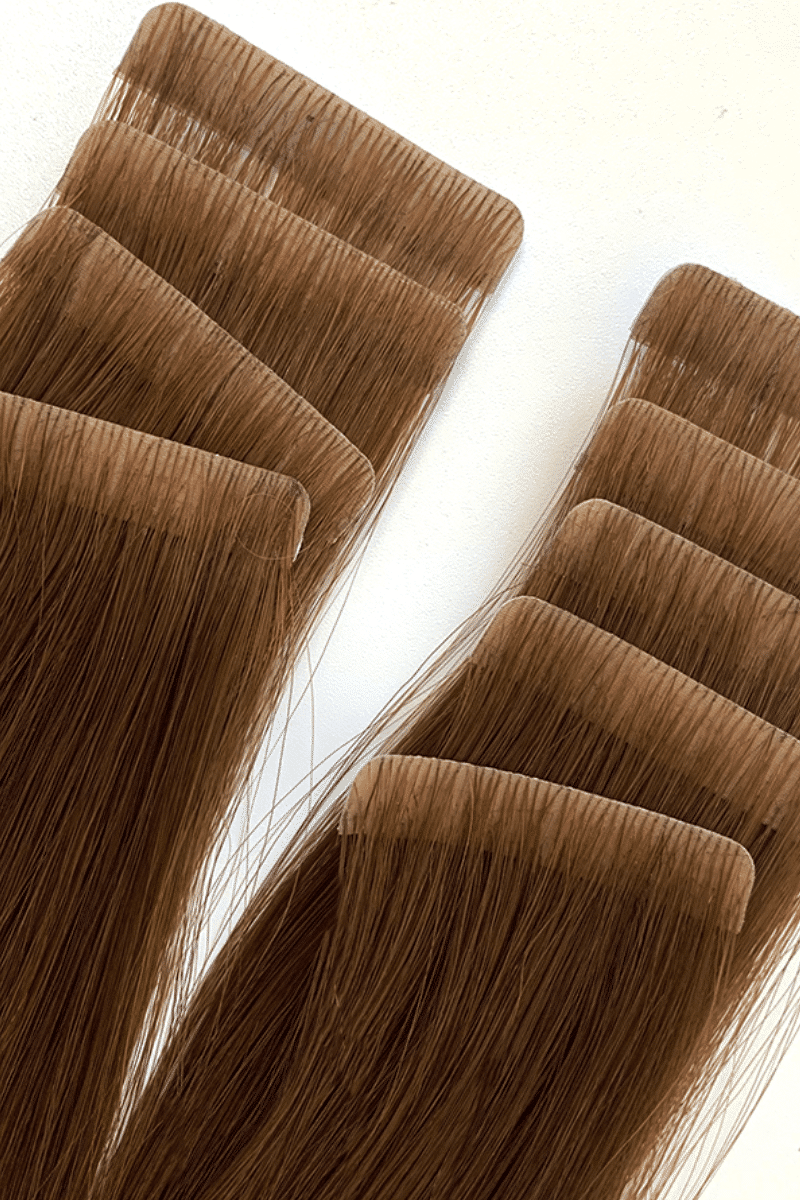Prepare to feel like a Bachelor contestant.
I did a bad thing. I cheated on my hairstylist when I desperately needed a trim and ended up leaving with four inches chopped off…and some super-short, crazy-unflattering layers. Need a visual? My hair looked like a botched version of Jennifer Anniston’s iconic Rachel cut. When I returned to my OG stylist a few months later, he told me I had two options: (1) suffer through an awkward grow-out phase or (2) cut it even shorter. Cue the obsessive Google searches for hair-growth vitamins and hair extensions.
After doing a little ~research~ for an alternative that wouldn’t totally damage my hair, I decided my best option was to try tape-in hair extensions (which, BTW, aren’t as major of a commitment as sew-in extensions but last way longer than clip-ins—more on that in a bit). And since tape-in extensions are installed and removed without any heat, chemicals, or invasive techniques, I figured it was my safest option for fixing my shitty haircut as quickly (and safely) as humanly possible.
What are tape-in hair extensions?
One of the first things I learned? Tape-in hair extensions aren’t really something you can DIY on your own. Unlike clip-in extensions, which are cheaper (like, you can get them on Amazon cheap) and good for a night out, tape-in extensions are a semi-long commitment that you’ll definitely want to leave to the pros.
For my new hair, I went to the SUPER REMY HAIR, since the technique of tape-ins involves carefully (and precisely) taping thin, inch-wide wefts of hair between your natural hair to beef up your length and texture. Tape-ins come pre-taped—each of my wefts had a single side of adhesive—that are then “sandwiched” between your natural strands.
Even though the process requires skill, it’s worth noting that tape-in extensions are suuuuper gentle on your hair and scalp (thanks to the fact that there’s no tugging or sewing during the application and removal). That makes tape-ins especially great for people with thin and/or damaged hair that are looking to add some length and thickness (or, you know, anyone with a terrible haircut).
How much do tape-ins cost?
The price of tape-in extensions varies, depending on the length, color, quality, and your salon. If you want a ballpark number based on my experience, here’s some quick math: My hair is super thick, so I needed 40 “sandwiches” (or 80 individual tape wefts) installed over the course of two hours. I got a combination of Super Remy Hair tape-ins that come in 10-piece packs ranging from $120 to $160. That adds up to about $1,120 worth of hair plus an extra $800 for the installation. Not cheap, I know.
But like I said, I have more hair than a litter of shih tzus, so this is truly on the extreme side. For comparison’s sake, Super Remy Hair recommends just three packs for thin hair, four for medium, and five for thick—it’s all based on the density of your natural hair—so most people will spend less than half of what I spent.
Here’s my final hair, in all of its glory, by the the end of my two-hour appointment:
P.S. A few days after these photos were taken, I went back to the Supers Room for a little trim. A stylist will usually blend and cut the extensions a bit for you immediately after installation, but we decided to leave all 20 inches for a few days before going in with scissors because…I am now a person with extreme haircut trust issues.
How long do tape-in hair extensions last?
Typically, tape-ins should last anywhere from 6 to 10 weeks after your installation, depending on how fast your hair grows. When you return for a reinstallation, your stylist will use a gentle bond remover to separate and slide the sandwiches out. Then they’ll replace the old tape on the wefts with new tape and put it back in your hair. As long as you take excellent care of them, you can reuse your extensions up to three times, which brings me to…
How do you maintain tape-in hair extensions?
Maintenance-wise, you can put tape-in extensions somewhere between owning a plant and having a pet. Although you can continue to wash and style your hair as you normally would, there’s definitely some daily care involved. I found it super helpful to sleep in a loose braid to avoid tugging the wefts at night (a silk pillowcase was also a huge help at preventing tangles and knots), along with a weekly mask to keep my hair looking soft and shiny.
One thing I had to get used to: Even though serums and oils are fine at the ends of your hair, you gotta keep them away from the tape to avoid messing with the adhesive. Which means no deep-oil treatments or heavy, oil-based products around the scalp. Oh, and heat protectant? Yeah, it’ll become your best friend if you’re trying to keep your extensions in great shape.
The pros and cons of tape-in extensions
Most of the horror stories you hear about tape-in extensions—e.g., hair breakage, issues with the adhesive, shedding, slippage, etc.—have to do with the installation, not necessarily the hair. The fate of your extensions is pretty much up to you and your stylist. If someone does a bad job putting them in (or you do a bad job taking care of them), you’re going to have a hard time overall. But as long as you’re buying high-quality extensions and having them installed by a well-reviewed professional, you’ll be fine.
Still, that’s not to say tape-in extensions are right for everyone. Before you make an appointment, here are the pros and cons you can expect to deal with:
PROS:
- You can style your hair as your normally would.
- Tape-ins allow you to add color without bleaching or dyeing your hair.
- The installation and removal are quick and damage-free.
- The wefts are usually thin, so they’re comfortable to wear and disguise.
CONS:
- They can definitely be pricey.
- You need to maintain extensions daily if you want them to last.
- Styling and wearing more hair than normal can be an uncomfy adjustment at first.
Are tape-in extensions worth it?
I hated my hair so much after a bad cut that I was willing to try anything to fix it, and tape-ins definitely did the trick. I had Bachelor-contestant hair in about two hours, along with the peace of mind that I could have it all easily removed as soon as I got tired of it. Plus, I was able to add highlights without bleaching my hair. It’s definitely a lot of work to wash and blow-dry a head of 40 tape-in bonds, but I truly love the look, so IMHO, it’s worth it.




